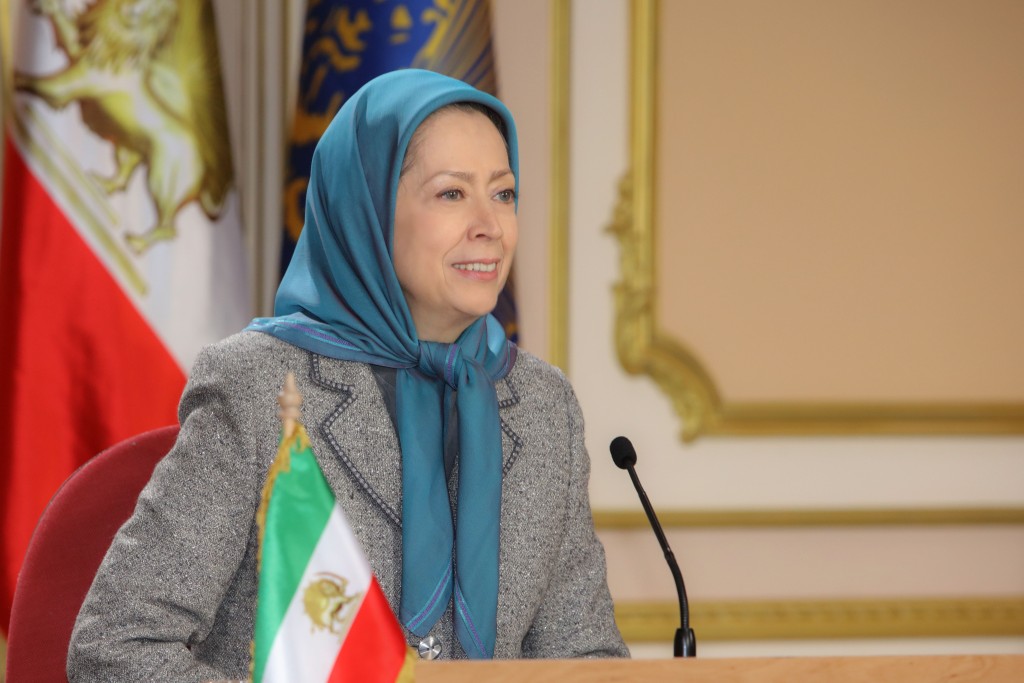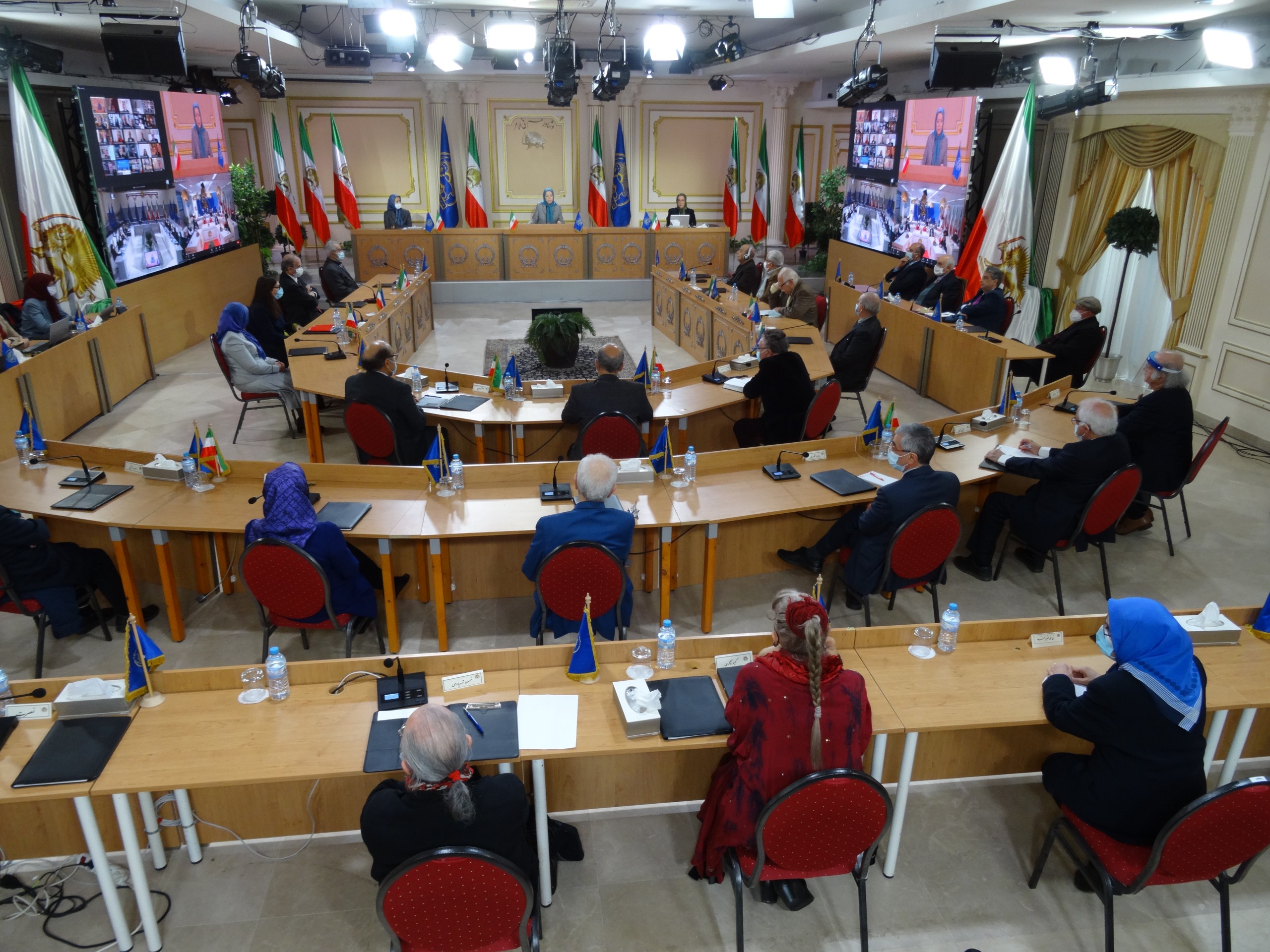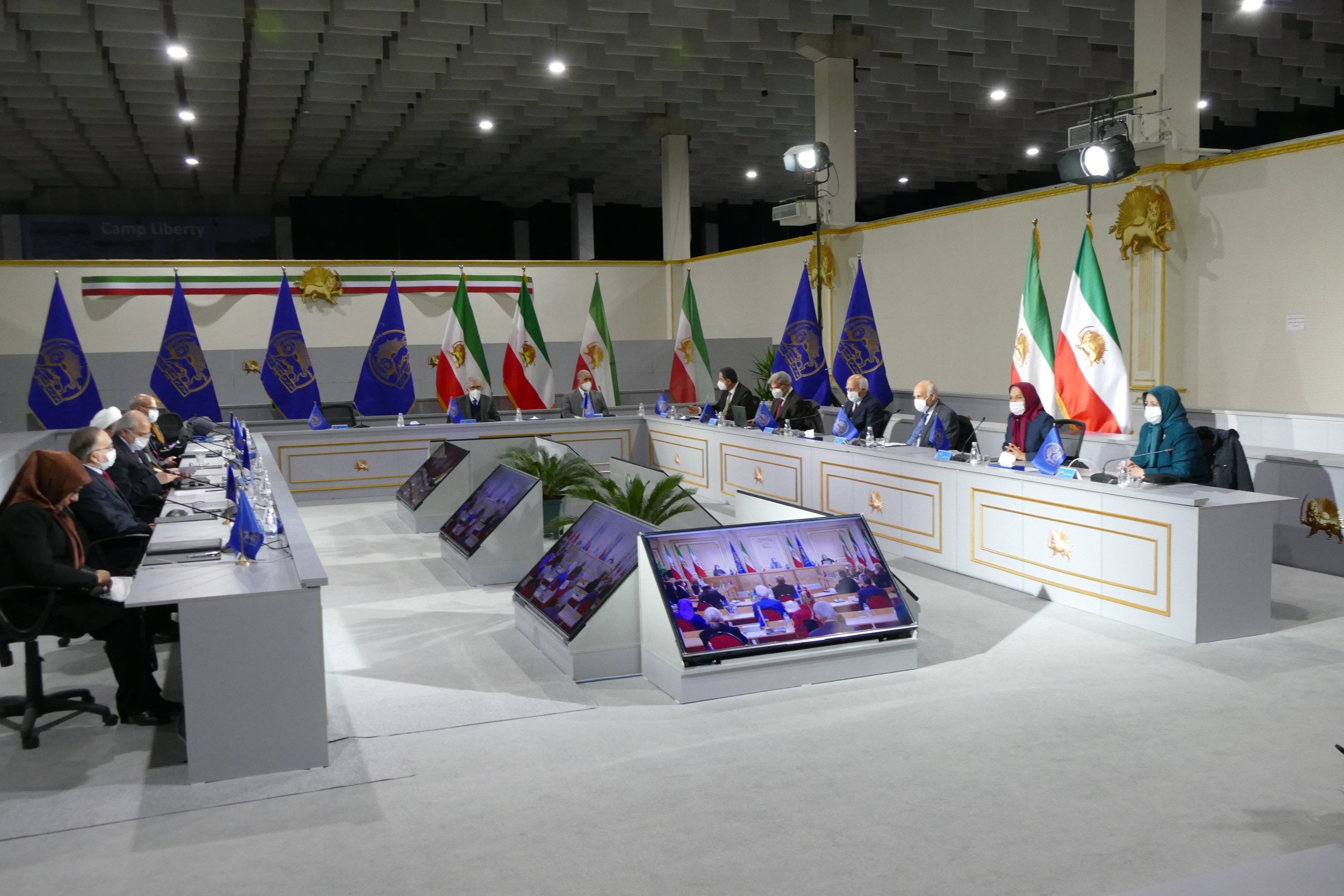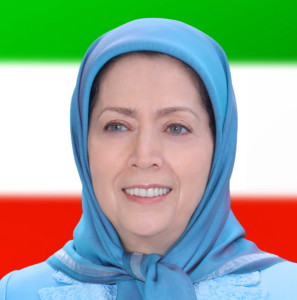National Council of Resistance of Iran- Mid-term session

Maryam Rajavi’s remarks
The mid-term session of the National Council of Resistance of Iran (NCRI) convened in Auvers-sur-Oise, Paris, on Monday, December 27, 2021. The NCRI President-elect Mrs. Maryam Rajavi presided over the session.
NCRI members and observers participated in the meeting virtually from dozens of locations in the U.S., France, Germany, Britain, Sweden, the Netherlands, and Ashraf 3 in Albania.
The session opened with the anthem “O’Iran, Land of Jewels.” In her remarks to the meeting, Maryam Rajavi welcomed the participants and said:
Greetings and welcome to the honorable members of the National Council of Resistance and all friends participating in the session as observers. I welcome you all.
Although many friends are connected virtually, it is a blessing that we can see one another again is such a gathering.
Let me begin by commemorating all the NCRI members who are no longer among us. Their memories and values will forever be with us. I pay tribute to Abbas Modarressi, who led a relentless life of struggle for more than 60 years against two dictatorships and was a legend of resistance and steadfastness. May his pure soul rest in peace with other deceased resistance members.
We begin the NCRI’s mid-term session by praising the bravery and selflessness of Iran protesters and in the name of the uprising of the people of Isfahan and the nationwide protests of teachers.
We remember the suffering and sacrifices of Isfahan’s deprived and oppressed people and all women and men who rose up. Unfortunately, Khamenei’s IRGC ruthlessly attacked them. This time, they targeted the protesters’ eyes.
Upon seeing their injured and bleeding eyes, I remembered Massoud Rajavi’s historical remarks in Tehran’s Amjadieh Stadium, when he said:
“For our people to see, how many eyes must we lose! The lights of these eyes that keep alight the people’s path, will stem from the eyes of the best of its children.”
We also commemorate the two major uprisings in December 2009 and December 2017-January 2018, which highlighted the Iranian people’s desire to overthrow the clerical regime.
Consequences of Raisi’s taking office
By appointing the mass murderer Ebrahim Raisi as president, the mullahs’ supreme leader Ali Khamenei stepped up domestic suppression, escalated arrests and executions, and ramped up pressure on political prisoners. Nevertheless, the people of Iran continue their protests and uprisings one after the other. There has been one major uprising every four months in the past year. This powerful wave is a continuation of a new era in the Iranian protest movement that began with the December 2017-January 2018 uprising.
The teachers’ recent nationwide protests and months-long strikes and sit-ins by workers of the oil and gas industry, petrochemical industry, and power plants are prominent examples of this powerful movement.
The most important features of this movement are its continuity, nationwide scale, and the unity among various social sectors. Thus, the movement carries within it a potent and powerful force for change, that can be organized and is a never-ending source for new Resistance Units.
Since Ebrahim Raisi, the mass executioner of 1988, took office, and due to his unpopular plans that have led to a several-fold rise in prices, the conflict between the deprived and hard working people of Iran and the anti-popular regime has intensified. The conflict is reflected in the budget bill for the new fiscal year that allocates 35% of the budget to military and security affairs, not considering other secret allocations.
The flip side of this policy is to plunge tens of millions of Iranians into misery. Living conditions for most workers, government employees, nurses, and teachers have deteriorated into instability and poverty. They lack housing security and proper medical care. The mullahs’ predatory regime even deprives people of their meager ration of bread.
In addition, the number of Covid-19 victims nears half a million. Every day we see more reports on this tragedy, with children and students joining the growing number of cases.
Khamenei is personally responsible for these many deaths, as he is also responsible for the people’s painful poverty. He sacrifices the Iranian people’s lives to preserve his decadent anachronistic rule. As the NCRI Chairman pointed out last March, “Khamenei and Rouhani have undertaken the policy of massive human casualties. As they did during the unpatriotic war (with Iraq) and the 1988 massacre of political prisoners, they are sending people to the Covid-19 minefields to protect the regime from the danger of uprisings and overthrow while the regime is under international sanctions.”
Khamenei and his accomplices foolishly believe that they could prolong their rule by depriving people of their rights and freedoms. However, our people are rising up against the regime. They say that in addition to freedom, democracy, and equality, they have a right to health, housing, jobs, free education, access to inexpensive water, power, gas, and gasoline, and a life free from want and affliction.
At this point, on behalf of the National Council of Resistance of Iran, I declare that we are committed to the Iranian people and history to restore our people’s trampled freedoms and rights. Our pledge is to the 120,000 who laid down their lives for freedom.

Wasting time in the nuclear talks
As you know, the clerical regime’s central political issue internationally is the nuclear program and the fate of JCPOA. The course of events shows that the general framework of the regime’s policy is to continue to evade and delay so to achieve nuclear weapons production capability.
In contrast, relevant Western government officials repeatedly express frustration about the future of the agreement.
According to the regime’s most senior officials, the regime began expanding its nuclear program immediately after signing the July 2015 nuclear deal.
Although the Iranian Resistance repeatedly disclosed the regime’s secret nuclear activities in the aftermath of the nuclear deal, Western governments disregarded these revelations and warnings by the International Atomic Energy Agency because they do not want to head off prospects for reaching an agreement with the regime.
They undertook a totally mistaken course of action, including:
– by giving up on six UN Security Council resolutions against the mullahs,
– by removing the regime from under Chapter Seven of the UN Charter ,
– by turning a blind eye to the regime’s completion of its nuclear weapons program and its warlike actions in the region,
– and by handing over frozen assets, which the regime devoted entirely to the Revolutionary Guards, nuclear and missile programs, and criminal ruling factions.
These are all missteps in a totally wrong direction that must be corrected by reactivating the six UN Security Council resolutions. But I repeat that the definitive solution and the correct response to this mistake is to stand with the Iranian people, their uprisings and their Resistance. A solution that the West has avoided until now, namely to recognize the Iranian people’s struggle to overthrow the regime.
Nevertheless, as far as the NCRI is concerned, we all know that since two decades ago, the NCRI chairman has been saying to the regime, “Please retreat and see what will happen to you.”
Also, in one of the NCRI’s annual gatherings, I stressed that “the regime’s overthrow, democratic change, and the establishment of a free Iran are our responsibility and the responsibility of our people. At the same time, we welcome any form of retreat by the mullahs especially when it concerns human rights and its nuclear program. Such retreats will act as 1,000 chalices of poison and will serve the formation of 1,000 Resistance Units.”
History will not forget that international calls and warnings, including the UN Security Council’s successive resolutions failed to persuade Khomeini to end the war with Iraq. The decisive party that forced Khomeini to drink the chalice of poison of the ceasefire in the unpatriotic war, was the National Liberation Army of Iran and its successive operations.
Today, the way to disempower the regime in the region, end its warmongering, deprive it of the nuclear bomb, and halt its repression and terrorism machine is the overthrow of the religious dictatorship through an uprising by the Iranian people and Resistance and by the general army of freedom.
Witness testimonies presented a new understanding of the 1988 massacre
In recent months, we have all followed the trial of an executioner in the 1988 massacre that is being held in Stockholm, Sweden, and in Durrës, Albania, near Ashraf-3. The shocking testimonies of the plaintiffs and witnesses of scenes of the massacre have stirred public opinion.
It is true that Iranian society cannot forget the massacre of 30,000 PMOI/MEK and other prisoners in 1988. But horrific accounts by first-hand witnesses, by those who have personally experienced the death row, or witnessed the collective hanging of dozens of PMOI prisoners, have brought to light new images of this horrendous crime and have touched the hearts and minds of the people of Iran.
Clearly, the mullahs and their intelligence apparatus had not foreseen such consequences in their political calculations before launching their conspiracy against the Call-for-Justice Movement over the 1988 massacre. They planned to kill several birds with one stone. They wanted to tarnish and discredit the Call-for-Justice Movement, trivialize the number of the massacre victims, and deny the identities of the massacred PMOI/MEK prisoners.
During the trial, everyone saw that the executioner explicitly told the Swedish court that if he did not refer to the People’s Mojahedin as “the hypocrites” or a sect, the regime would arrest and punish even him. So it is that we gain better understanding of this most taboo name for the religious fascism.
It thus becomes clear that the use of the words “cult,” “sect,” and “hypocrites” by any person or group, indicates their link to the regime. During this trial, we saw that the regime and its mercenaries did everything in their power to deny the identity of the massascred PMOI prisoners. They sought to cover up the victims’ ideals and organization, especially the name of Massoud Rajavi, which the victims hailed as they walked to the gallows to make their eternal journey.
Fortunately, the People’s Mojahedin neutralized the mullahs’ plot, thanks to the solidarity and efforts of many compatriots, including various political groups and tendencies, the families of the martyrs and the survivors of the massacre inside Iran and abroad, and thanks to the valuable activities of PMOI members, supporters and officials as plaintiffs and witnesses in this case. With this campaign, the Call-for-Justice movement has reached new heights.
Also, with the impressive testimonies of the survivors, the trial of this executioner in Sweden triggered a wave of social and global revelations. Therefore, the whole conspiracy turned against Khamenei and his mass murderer president, Ebrahim Raisi.
On behalf of the National Council of Resistance of Iran, I would like to express my sincere gratitiude for all the efforts made in this campaign, including the testimonies of the survivors and the families of the martyrs, who showed solidarity and unity against the regime.
I would also like to pay tribute to the supporters of the Iranian Resistance who carried out this campaign for months with tremendous dedication and selflessness in the heat of summer and in the sub-zero cold of winter. These efforts have given new impetus to the Call-for-Justice Movement and encouraged our compatriots in Iran and abroad.
According to the book “Crime against Humanity”, the massacre of political prisoners took place in at least 110 cities in Iran. The same book reveals the names of 35 members of the Death Commissions responsible for the massacre in various provinces.
Thus, the Call-for-Justice Movement will carry on with its efforts until the stories of massacre in all these cities are revealed, until the complete list of the victims is obtained, until the victims’ places of burial are known in all corners of the country. The movement will continue its work until all the masterminds, perpetrators, and collaborators involved in this unspeakable crime are exposed and brought to justice in Iran and in the people’s courts.
And this movement will continue until the mullahs’ religious fascism is overthrown.
I thank you all.

- Tags: Iran protests, Maryam Rajavi, NCRI

